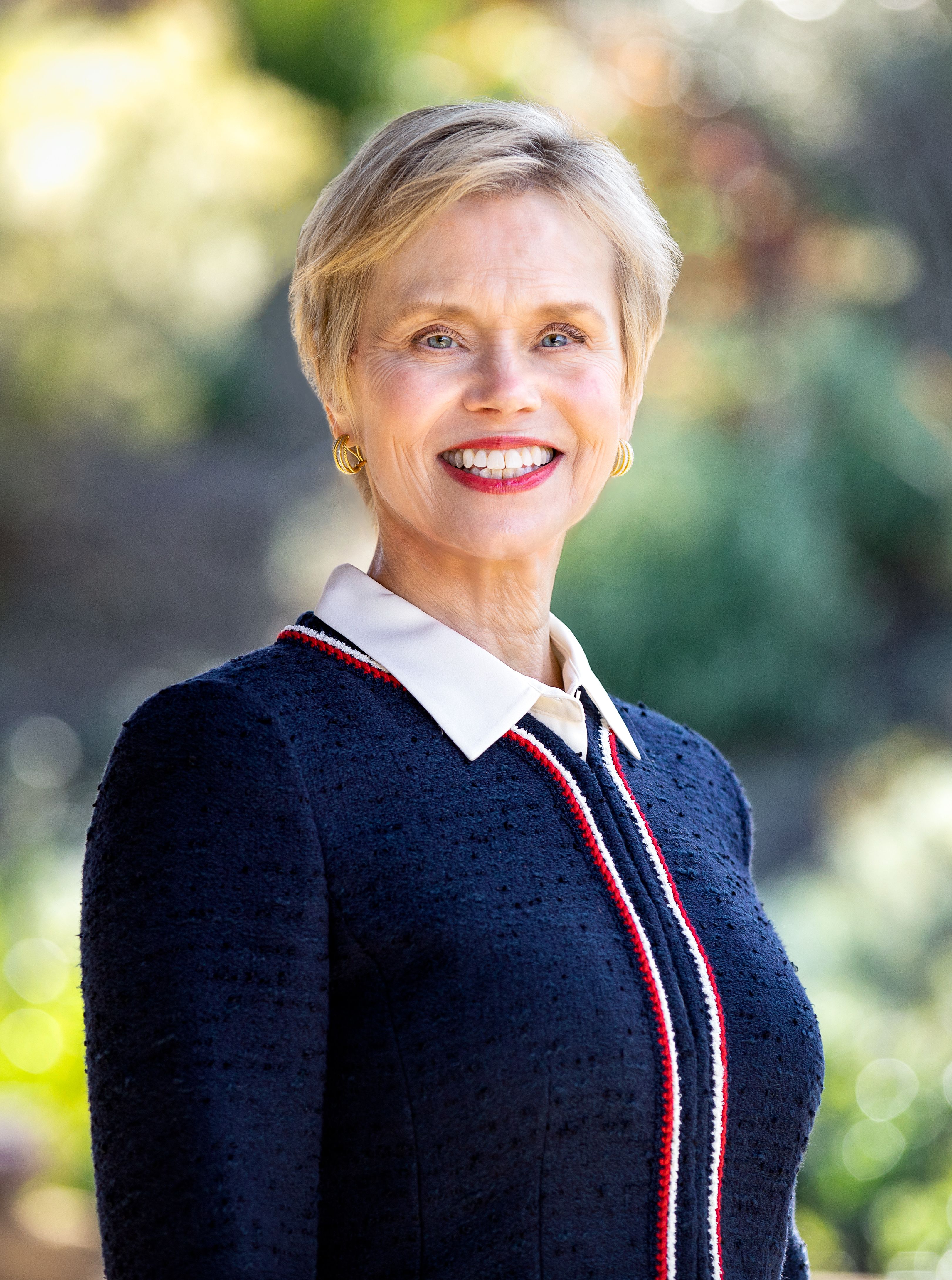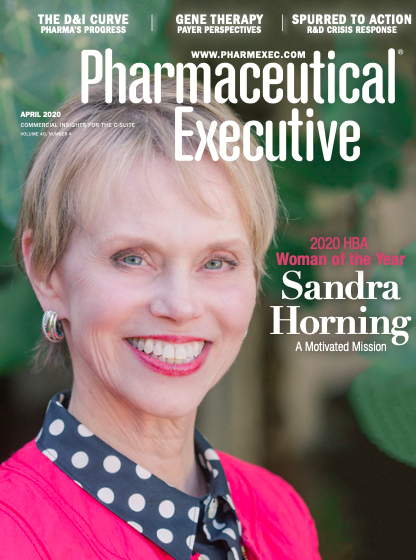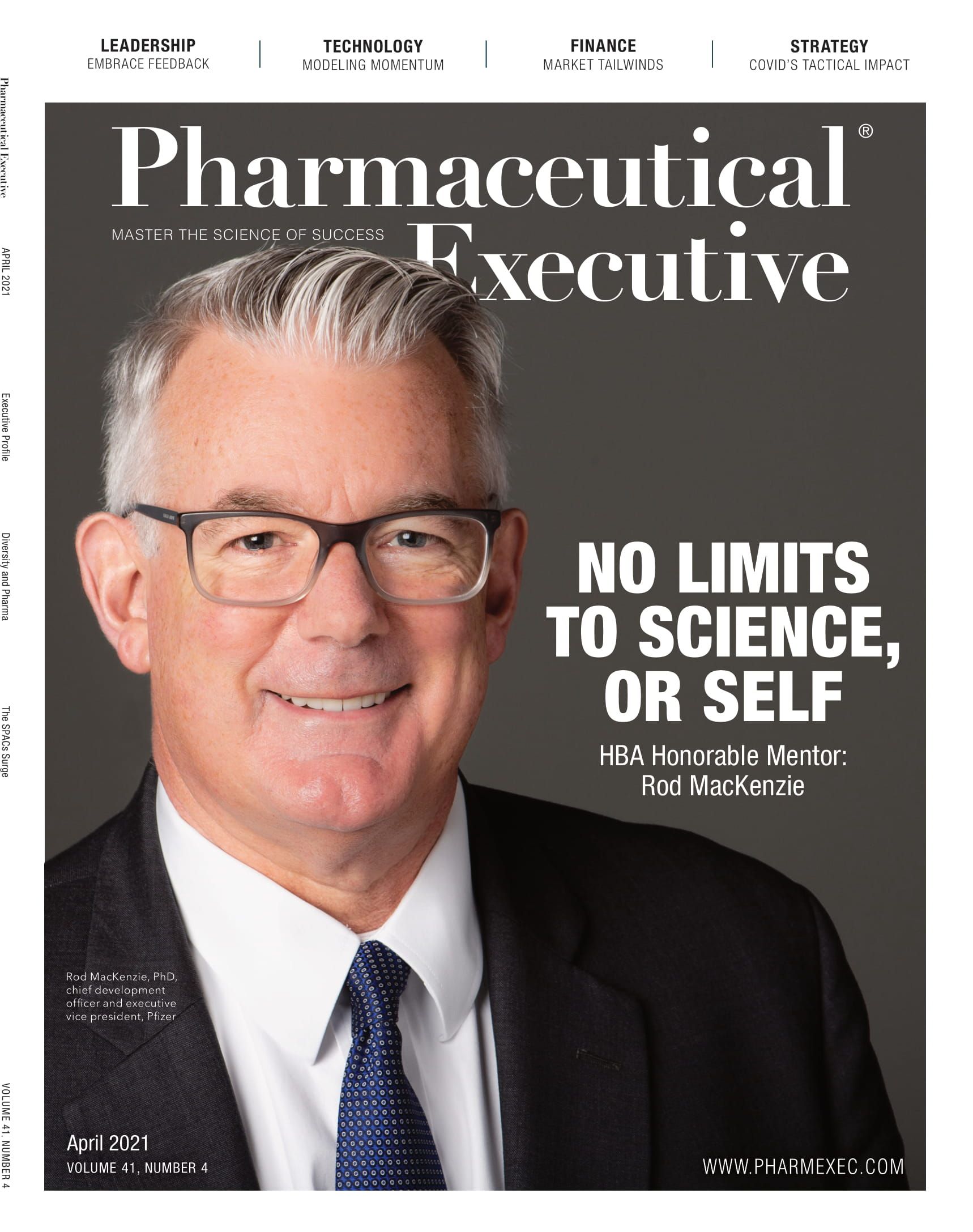Years in the Making: A Repeat Recognition—Uninterrupted
The Healthcare Businesswomen’s Association again names Sandra Horning its WoTY—where the pharma leader’s message of purpose and partnership takes on added resonance today.

COVID-19 might have ruined many plans last spring, but the Healthcare Businesswomen’s Association (HBA) is making sure its 2020 Woman of the Year (WoTY), Sandra Horning, MD, gets the recognition she deserves. The HBA has again named Horning its WoTY winner, for 2021, and will celebrate her in a virtual event on May 6. Ever so humble, Horning jokes her Woman of the “Years” status is due to the many years in her career.
The oncologist and former chief medical officer and head of global product development at Genentech and Roche has been busy since we last spoke. Shortly after being named the 2020 WoTY, COVID came to town. At that time, Horning was new to the boards of Gilead and Moderna—two companies that would be key players in the global health crisis.
When she began discussions with both companies in late 2019, COVID wasn’t yet a topic of discussion. By the time she attended her first meeting for each company as a board member in the new year, the virus was an add-on to the planned agenda. “From the very beginning, both companies recognized the importance of the emerging pandemic and the potential that they could serve to really help people and society,” says Horning.
Though she qualifies her involvement as a board member as being minor relative to others’ contributions, she still says it was “exhilarating” and “quite a privilege” to be a part of the process. “The most exciting day was when we first saw the Phase III vaccine results from Moderna,” says Horning. “They were outstanding and had exceeded our expectations. It was really breathtaking, knowing how much that can mean to people—to individuals, families, and global economies. At the end of March, I saw that Moderna had distributed 100 million doses of vaccine to date. The effort to scale up to get to that number is really pretty astonishing for a company that wasn’t expected to have a marketed product for several years.”
COVID collaboration and dedication
The past year has produced an all-hands-on-deck atmosphere at Gilead and Moderna, where Horning witnessed a good deal of personal sacrifice on all levels. As a board member, she attended committee meetings that were often unscheduled and sometimes as frequent as weekly. “I’ve appreciated the dedication I’ve seen of management and the team’s heroic efforts,” she says. “I’ve also been really impressed with the collaborations we’ve seen across the industry, in particular, the collaborations that both of these companies had with the National Institutes of Health in conducting high-caliber clinical trials in highly representative populations.”
If ever there was a time that put Horning’s motto of “patients are waiting” in the spotlight, 2020 was the year. While the sight of patients waiting in line to receive vaccines embodied this idea, the behind-the-scenes work of pharma also demonstrated it. “Everybody was acting with a sense of urgency, understanding that there’s a necessity for standards and quality and safety, but there are a lot of other things that can happen more quickly,” she says. “People were working 24/7.”
Horning believes the purpose-driven nature of pharma contributed to many unparalleled collaborations within the industry. She cites government support—not just financial and distribution support, but the regulatory agency’s flexibility—as being critical to this effort. What especially sticks out in her mind are the “courageous collaborations”—the joining of forces with competitors or others who traditionally might be thought of as barriers to progress. In addition to the obvious partnerships, such as Merck helping to manufacture vaccines for J&J, she mentions how quickly some collaborative clinical trials came together across companies. Risk-taking—from development to manufacturing investment—amid evolving information was also vital. “People have really been stepping up and thinking about how to do things differently,” she says.
Forging ahead in oncology
The dedication of pharma had another important effect on the industry, beyond COVID—it kept pipelines moving.
In oncology, this perseverance allowed clinical trials to progress at a time when all eyes were shifting toward COVID. A commitment to patients who might not have much time to live and their families was critical to sustaining programs.
Horning compares oncology to COVID in that it is an area that highlights the realized promise of science. The combination of understanding the disease, understanding the science, and the ability to marry that science with technology to translate it to the clinic with increasing success and speed has resulted in an explosion of therapies.

“If you think about where we are with COVID and the vaccines—and the first two vaccines to cross the line were mRNA vaccines—that didn’t happen overnight,” she says. “That happened with at least a decade of investment in recognizing the challenges and overcoming them so that mRNA was really primed to be a vaccine platform success when COVID-19 came to call.”
There are other crossovers when it comes to oncology and COVID. Many COVID therapeutics were advanced by prior work in oncology drug development. Because Moderna and Pfizer-BioNTech were already producing personalized cancer vaccines, they had manufacturing know-how in place. Of course, the enormous scale-up needed for the pandemic presented many new challenges. But mRNA technology had reached a point where it could be delivered safely and effectively and was showing promising early results in the area of vaccines, as well as early promising biomarker-based results in oncology.
This past November, Horning decided to lend her oncology expertise to another pharma board. Prior working relationships and promising preclinical data for Olema Oncology’s lead product drew her to the role. The company’s CERAN, or complete estrogen receptor antagonist, is being developed for hormone receptor-positive breast cancer. “I was drawn to this because breast cancer is the most prevalent type of cancer in women—about 70% are HR positive—and I have a personal family history with breast cancer, so in a way, this felt like it could be a little bit of giving back through this promising molecule.”
Though she was looking forward to working with an emerging company, Olema went public faster than she had imagined, so she wasn’t able to capture much of that experience. Nevertheless, being a part of a company that doesn’t have a large portfolio or pipeline, like Gilead and Moderna do, offers the opportunity for greater focus.
Women as leaders
Horning recognizes the need for strong role models in the sciences and is delighted to see the work of women being recognized in the news. From mRNA pioneer Katalin Karikó to BioNTech’s Özlem Türeci to Pfizer’s Kathrin Jansen, she is hoping their work will inspire others, especially young women and girls.
“I’ve read some of the articles that have been singularly devoted to the role of women in the COVID-19 epidemic,” she says. “It’s just so important to have these stories out there because they are inspirational. We know from areas like sports and entertainment that when there is this recognition, it incites a passion and determination in young people to say, ‘I want to do that’ or ‘I want to be like her.’”
She also mentions that for the first time, two women recently won the Nobel Prize in Chemistry: Emmanuelle Charpentier and Jennifer Doudna, for gene editing.
“Having these two women who have reached the absolute peak as Nobel laureates is going to have huge impact,” she says. “I’m also really excited that Walter Isaacson—who has written about Leonardo da Vinci, Benjamin Franklin, and Steve Jobs—just wrote a biography of Jennifer Doudna. This, too, should inspire millions of young people, especially girls.”
As Horning welcomes her renewed WoTY recognition, her own status as a role model and mentor continues. Though she is reticent to see herself in this way, she says that as a physician and leader she has always aimed to set a good example. She hopes her purpose-driven passion to improve the lives of patients and their families is what people admire about her work.
“The elements of being a good role model for leadership are to be curious and to be continuously learning,” she says. “It’s about having courage to make decisions or to call out things that need changing. It is about being objective about data and people. It’s also about being humble.”
Elaine Quilici is Pharm Exec’s Senior Editor. She can be reached at equilici@mjhlifesciences.com.
